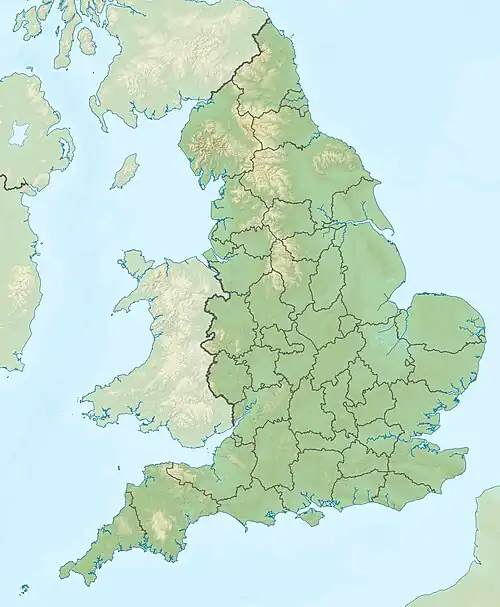| Vectis Formation | |
|---|---|
| Stratigraphic range: Early Aptian ~ | |
| Type | Geological formation |
| Unit of | Wealden Group |
| Sub-units | Shepherds Chine, Barnes High Sandstone & Cowleaze Chine Members |
| Underlies | Atherfield Clay Formation |
| Overlies | Wessex Formation |
| Thickness | Up to 66 m (217 ft) |
| Lithology | |
| Primary | Siltstone, mudstone |
| Other | Sandstone, limestone, ironstone |
| Location | |
| Coordinates | 50°42′N 1°06′W / 50.7°N 1.1°W |
| Approximate paleocoordinates | 40°48′N 9°42′E / 40.8°N 9.7°E |
| Region | England |
| Country | |
| Extent | Dorset, Isle of Wight |
 Vectis Formation (England) | |
The Vectis Formation is a geological formation on the Isle of Wight and Swanage, England whose strata were formed in the lowermost Aptian, approximately 125 million years ago.[1][2] The environment of deposition was that of a freshwater coastal lagoon with occasional marine influence after the early Aptian marine transgression, transitioning from the floodplain environment of the underlying Wessex Formation. The primary lithology is of laminated grey mudstones. The Vectis Formation is composed of three geological members: the Shepherds Chine member, the Barnes High Sandstone member, and the Cowleaze Chine member. It is overlain by the fully marine Atherfield Clay Formation, part of the Lower Greensand Group. Dinosaur remains are among the fossils that have been recovered from the formation.[3]
Fauna
- Theropod tracks[3]
- Polacanthus foxii[3]
- Hypsilophodon foxii[3]
- Euornithopoda indet.[3]
- Euornithopod tracks[3]
- Mantellisaurus atherfieldensis[3]
- Spinosaurinae indet.[4]
- Vectocleidus pastorum[5]
- Hylaeochampsa vectiana[6]
See also
References
- ↑ "Magnetostratigraphy of the Lower Cretaceous Vectis Formation (Wealden Group) on the Isle of Wight, Southern England."
- ↑ Batten, D. J. (ed.) 2011. English Wealden Fossils. The Palaeontological Association, London.
- 1 2 3 4 5 6 7 Weishampel, David B; et al. (2004). "Dinosaur distribution (Early Cretaceous, Europe)." In: Weishampel, David B.; Dodson, Peter; and Osmólska, Halszka (eds.): The Dinosauria, 2nd, Berkeley: University of California Press. Pp. 556-563. ISBN 0-520-24209-2.
- ↑ Barker CT, Lockwood JA, Naish D, Brown S, Hart A, Tulloch E, Gostling NJ (2022). "A European giant: a large spinosaurid (Dinosauria: Theropoda) from the Vectis Formation (Wealden Group, Early Cretaceous), UK". PeerJ. 10: e13543. doi:10.7717/peerj.13543. PMC 9188774. PMID 35702254.
- ↑ Benson, Roger B. J.; Ketchum, Hilary F.; Naish, Darren; Turner, Langan E. (11 December 2012). "A new leptocleidid (Sauropterygia, Plesiosauria) from the Vectis Formation (Early Barremian–early Aptian; Early Cretaceous) of the Isle of Wight and the evolution of Leptocleididae, a controversial clade". Journal of Systematic Palaeontology. 11 (2): 233–250. doi:10.1080/14772019.2011.634444. S2CID 18562271.
- ↑ Clark; Norell, James; Mark (January 1992). "The Early Cretaceous crocodylomorph Hylaeochampsa vectiana from the Wealden of the Isle of Wight". American Museum Novitates: 19.
{{cite journal}}: CS1 maint: multiple names: authors list (link)